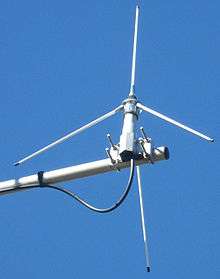Feed line
| Part of a series on |
| Antennas |
|---|
 |
|
Common types |
|
Radiation sources / regions |
In a radio antenna, the feed line is the cable or other transmission line that connects the antenna with the radio transmitter or receiver. In a transmitting antenna, it feeds the radio frequency (RF) current from the transmitter to the antenna, where it is radiated as radio waves. In a receiving antenna it transfers the tiny RF voltage induced in the antenna by the radio wave to the receiver. In order to carry RF current efficiently, feed lines are made of specialized types of cable called transmission line. The most widely used types of feed line are coaxial cable, twin-lead, ladder line, and at microwave frequencies, waveguide.
Particularly with a transmitting antenna, the feed line is a critical component that must be adjusted to work correctly with the antenna and transmitter. Each type of transmission line has a specific characteristic impedance. This must be matched to the impedance of the antenna and the transmitter, to transfer power efficiently to the antenna. If these impedances are not matched it can cause a condition called standing waves on the feed line, in which the RF energy is reflected back toward the transmitter, wasting energy and possibly overheating the transmitter. This adjustment is done with a device called an antenna tuner in the transmitter, and sometimes a matching network at the antenna. The degree of mismatch between the feedline and the antenna is measured by an instrument called an SWR meter (standing wave ratio meter), which measures the standing wave ratio (SWR) on the line.
Twin-lead
Twin lead is used to connect FM radios and television receivers with their antennas, although it has been largely replaced in the latter application by coaxial cable, and as a feedline for low power transmitters such as amateur radio transmitters. It consists of two wire conductors running parallel to each other with a precisely constant spacing, molded in polyethylene insulating material in a flat ribbon-like cable. The distance between the two wires is small relative to the wavelength of the RF signal carried on the wire. Furthermore, the RF current in one wire is equal in magnitude and opposite in direction to the RF current on the other wire (it is inverted). Thus, if both wires radiate energy equally, the radiated energies will cancel each other out and there will be near zero radiation at any distance from the wire. Twin lead is also immune to external noise or RF energies. Any unwanted external noise or unwanted RF energy induced on the wire from external energy sources will be induced in both wires at the same time and equally in magnitude and direction. At the end of the transmission line the inverted signal wire is restored to normal (non-inverted now) and added back to the original non-inverted signal wire by the receiving circuitry. Any noise will now be equal in magnitude and opposite in direction and cancel itself out.
Twin lead is considered a balanced transmission line.
Coaxial cable

Coaxial cable is probably the most widely used type of feedline, used for frequencies below the microwave (SHF) range. It consists of a wire center conductor and a braided or solid metallic "shield" conductor, usually copper or aluminum surrounding it. The center conductor is separated from the outer shield by a dielectric, usually plastic foam, to keep the separation between the two conductors precisely constant. The shield is covered with an outer plastic insulation jacket. In hard coax cable, used for high power transmitting applications like television transmitters, the shield is a rigid or flexible metal pipe containing a compressed gas such as nitrogen, and the internal conductor is held centered with periodic plastic spacers. Coaxial cable's advantage is that the enclosing shield conductor isolates the cable from external electromagnetic fields, so it is very immune to interference.
Coaxial cable is considered an unbalanced line.
Waveguide
Waveguide is used at microwave (SHF) frequencies, at which other types of feedline have excessive power losses. A waveguide is a hollow metallic conductor or pipe. It can have a circular or square cross-section. Waveguide runs are often pressurized with nitrogen gas to keep moisure out. The RF signal travels through the pipe similarly to the way sound travels in a tube. The metal walls keep it from radiating energy outwards and also prevent interference from entering the waveguide. Because of the cost and maintenance waveguide entails, microwave antennas often have the output stage of the transmitter or the RF front end of the receiver located at the antenna, and the signal is fed to or from the antenna at a lower frequency, using coaxial cable.
A waveguide is considered an unbalanced transmission line.
Feed line characteristics
This is a comparison of a few common feed line characteristics. Larger lists are available in other articles, references, and directly from manufacturers.
| type | impedance (Ω) | Velocity Factor (%c) |
|---|---|---|
| twin-lead | 300 | 82% |
| ladder line | 450, 600 | 95% |
| coax | 50, 75 | 66% |
| Wikimedia Commons has media related to Transmission lines (radio). |